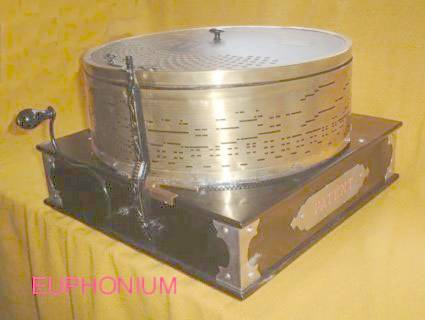| You Are Not Logged In | Login/Get New Account |
|
Please Log In. Accounts are free!
Logged In users are granted additional features including a more current version of the Archives and a simplified process for submitting articles. |
|
MMD
 Pictures
Pictures
 euphonium1
euphonium1
|
|
End-of-Year Fundraising Drive In Progress. Please visit our home page to see this and other announcements:
https://www.mmdigest.com Thank you. --Jody
|
|
by Christian Greinacher (020223 MMDigest) and Nicholas Simons (020224 MMDigest)
A friend of mine asked me to restore a very rare instrument for him, called "Euphonium". I was happy to do this difficult job because it gives me the opportunity to learn more about this more or less unknown instrument. I will send two pictures which show how it looks like and how it is labeled. The overall size is 400 mm by 400 mm by 250 mm high. It has a scale of 24 notes (playing 28 reeds). The music is punched into an exchangeable brass strip, 110 mm wide and 1195 mm long, soldered to a ring which is moved around a metallic cylinder on top of the wooden box. In and onto the wooden box are mounted two pumping bellows and a magazine bellows, the wind chamber with the 28 brass reeds, the valves and the mechanism to activate the valves. On the top of the box is printed "Euphonium, Patent". Nothing else is written or printed inside or outside. Nowhere in the literature available to me is this Euphonium mentioned. The only related information we could get comes from La Galleria Armonica, Museo degli Strumenti Musicali di Roma. That museum owns two Euphonium "wrecks" in non-playable condition (inventory numbers 490 and 491); they call it "an unknown table crank reed organ". They know that their instruments were bought by an Italian collector after 1890, and they guess that the Euphonium was built by the Euphonika Musikwerke in Leipzig, Germany, probably because of the similarity of the names.
Who owns an Euphonium? Is somewhere in the world such a brass strip which could fit the Euphonium? (We only have one, and it was quite a bit of work to restore it!) Yesterday I finished the restoration of our Euphonium; now it looks and it plays excellently! I hope to get some answers to this posting in order to include the information hopefully provided into my restoration report. When this report will be finished, I will publish it via the MMD (provided Robbie will accept around 10 pages of text and many many pictures). [ With pleasure! Send email to editor@foxtail.com> -- Robbie ] Looking forward to the answers of all Euphonium collectors. Christian Greinacher, Germany
Christian Greinacher's Euphonium most closely resembles the Kalliston range of organettes. The smallest Kalliston, that without bells, uses a zinc music band that is 110 mm wide, 1200 mm long and plays 24 notes. Christian says that his music is brass but the photo shows a colour more like zinc. The Kalliston band overlaps by 10 mm at the joint, which is comprised of two small brass studs which fit into a pair of keyhole shaped slots in the other end, then each is covered by a thin brass shim. If one were to solder the band into a permanent ring the dimensions would be as described by Christian. This could be more than a coincidence. It is possible that the Euphonium was designed to play Kalliston bands and that Christian's one band has previously been soldered into a complete ring due to damage. Alternatively, the band is indeed different, but from the same supplier using identical arrangements, and this leads on to a suggestion for new music. The handful of Kalliston owners could be asked to mark through their music and this could be punched onto zinc strips. Some years ago, Bob Yates in the USA was trying to organise a Kalliston band copying programme but I think this never got off the ground. If he is reading this could he please report? It is most unlikely that the music bands were originally soldered into complete rings as this would make storage almost impossible since one could not nest the individual rings as they are all of the same circumference. This therefore supports the above hypothesis. I may be totally wrong but I suggest that the Euphonium is a little known brother of the Kalliston. Kind regards from the English Midlands,
24 February 2002 |
|
|
|
|
|
|
|
|
|
CONTACT FORM: Click HERE to write to the editor, or to post a message about Mechanical Musical Instruments to the MMD Unless otherwise noted, all opinions are those of the individual authors and may not represent those of the editors. Compilation copyright 1995-2025 by Jody Kravitz. Please read our Republication Policy before copying information from or creating links to this web site. Click HERE to contact the webmaster regarding problems with the website. |
|
|
||||||
|

 Questions:
Is there anybody who could provide any more information about the Euphonium?
Who built it? When? Where?
Questions:
Is there anybody who could provide any more information about the Euphonium?
Who built it? When? Where?